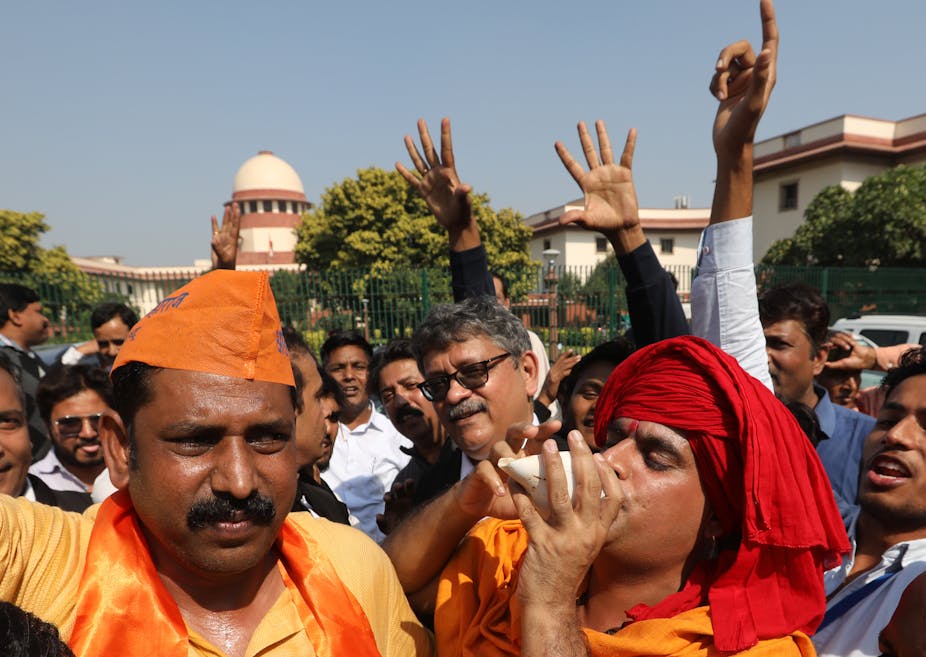The recent anniversary of the demolition of Babri Mosque in the Indian city of Ayodhya in December 1992 played out under a heavy security deployment and high alert. The mosque, which was built by the Mughal emperor Babur in the 16th century, was manually demolished by activists, supporters and volunteers of the Hindu nationalist organisation Vishva Hindu Parishad (VHP).
Their claim was that the same land was the birthplace of the Hindu deity Lord Ram and that the mosque was built after the destruction of a temple which originally stood on that spot. The demolition led to an outburst of communal violence and rioting across India, most notably in Mumbai, then Bombay.
In the past, the day has been marked by contrasting commemorations by different communities. Hindu nationalist organisations celebrated it as “Shaurya divas” (day of bravery), while Muslims observed as “Black Day”.
This year, even though the anniversary passed peacefully, it assumed an added aura of tension. It came on the heels of a landmark decision in early November by the Supreme Court of India on the protracted and contentious land dispute in Ayodhya. At the core of the case was the question of the contested ownership of the piece of land where the Babri mosque once stood.
Nearly 30 years after the demolition of the mosque, the legacy of the event continues to influence India’s secular fabric and the politics around communal identity. The court’s ruling also has implications for the “idea of India” in the future. This occupation with the fashioning of national history and national memory in India and the ways in which they are contested is something that I’m focusing on in my ongoing research on memory politics in South Asia.
Competing versions of history
The recent judgment sought to settle the dispute in a fair and reasonable manner acceptable to all the parties concerned. The court ruled that a temple for Lord Ram shall be built on the location of the demolished mosque and that a separate five acres of land at another prominent location in the city shall be provided to Muslims for the construction of a mosque.
The ruling received a mixed response from the Muslim community, ranging from welcome acceptance, tired resignation to angry rejection. And the December anniversary of the mosque demolition was met with the filing of six petitions with the Supreme Court to review the decision.
At the centre of the dispute and the years of litigation surrounding it is history itself and how it is used in seeking legitimacy for contested and competing versions of the past. History also becomes a means for communities to write themselves into the nation’s collective memory, passed on from one generation to next.
The Babri mosque had been a place of worship where the city’s Muslims had offered their prayers in continuity since medieval times until late December 1949, when idols of Lord Ram were stealthily placed inside its premises. However, the narrative of the mosque’s significance goes beyond just that of a Mughal emperor constructing a mosque. For the Muslim community, it represents a symbol of Indo-Islamic heritage and their long presence in the everyday life and landscape of the city.
At the same time, for a section of the Hindu community and those claiming to represent them, the mosque represented a reminder of Muslim conquest and cultural subjugation and the act of its demolition was a way to reclaim history.
A quest for ‘truth’
The recent judgment on the Ayodhya case recognised how central history is to the dispute. By upholding the claim of the Hindus over the disputed land, the verdict ultimately favoured one quest for truth over the other. It is also the version of truth that is most agreeable with the vision of the party in power in India, the Bharatiya Janata Party (BJP) of the prime minister, Narendra Modi. The promise of the construction of the Ram temple has consistently featured in the BJP’s manifesto since 1996.
The verdict acknowledged that the litigants representing the deity Lord Ram were able to better establish a chain of unbroken Hindu possession of the inner courtyard of the mosque than their Muslim counterparts. The evidence of this continuous possession does not conclusively determine the land as the actual place of birth of Lord Ram, but according to the judgment, it does establish an unbroken Hindu belief that it was. At the same time the verdict also firmly states that the act of demolition of the Babri mosque was a violation of law.
The immediate responses to the ruling across the political spectrum in India in November were largely ones of acceptance, along with calls from leaders for the maintenance of communal peace and harmony. While such a display of bipartisan consensus over a contentious issue is rare in India and therefore heartening, it also draws attention to the potentially troubling state of political discourse in India. It begs the question of what is the scope for opposition, dissent and debate in the country.
Much as there exists a sense of exhaustion with the Ayodhya dispute and a desire for some much-needed closure, the verdict raises questions about the meaning the case holds for the future. Is this a judgment that rises above a politics of division embedded in the past or one that uses a certain reading of the past to further and favour the politics of the present? Once again, history shall be the judge of that.

